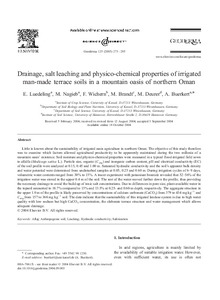| dc.date.accessioned | 2007-05-24T14:05:40Z | |
| dc.date.available | 2007-05-24T14:05:40Z | |
| dc.date.issued | 2005 | |
| dc.identifier.issn | 0016-7061 | |
| dc.identifier.uri | urn:nbn:de:hebis:34-2007052418313 | |
| dc.identifier.uri | http://hdl.handle.net/123456789/2007052418313 | |
| dc.format.extent | 585525 bytes | |
| dc.format.mimetype | application/pdf | |
| dc.language.iso | eng | |
| dc.rights | Urheberrechtlich geschützt | |
| dc.rights.uri | https://rightsstatements.org/page/InC/1.0/ | |
| dc.subject | Aflaj | eng |
| dc.subject | Anthropogenic soil | eng |
| dc.subject | Leaching | eng |
| dc.subject | Hydraulic conductivity | eng |
| dc.subject | Salinization | eng |
| dc.subject.ddc | 630 | |
| dc.title | Drainage, salt leaching and physico-chemical properties of irrigated man-made terrace soils in a mountain oasis of northern Oman | eng |
| dc.type | Aufsatz | |
| dcterms.abstract | Little is known about the sustainability of irrigated oasis agriculture in northern Oman. The objective of this study therefore was to examine which factors allowed agricultural productivity to be apparently maintained during the two millenia of a mountain oasis’ existence. Soil moisture and physico-chemical properties were measured in a typical flood-irrigated field sown to alfalfa (Medicago sativa L.). Particle size, organic (C_org) and inorganic carbon content, pH and electrical conductivity (EC)of the soil profile were analyzed at 0.15, 0.45 and 1.00 m. Saturated hydraulic conductivity and the soil’s apparent bulk density and water potential were determined from undisturbed samples at 0.05, 0.25 and 0.60 m. During irrigation cycles of 6–9 days, volumetric water contents ranged from 30% to 13%. A tracer experiment with potassium bromide revealed that 52–56% of the irrigation water was stored in the upper 0.4 m of the soil. The rest of the water moved further down the profile, thus providing the necessary drainage to avoid the build-up of toxic salt concentrations. Due to differences in pore size, plant-available water in the topsoil amounted to 18.7% compared to 13% and 13.5% at 0.25- and 0.60-m depth, respectively. The aggregate structure in the upper 1.0 m of the profile is likely preserved by concentrations of calcium carbonate (CaCO3) from 379 to 434 mg kg^-1 and C_org from 157 to 368 mg kg^-1 soil. The data indicate that the sustainability of this irrigated landuse system is due to high water quality with low sodium but high CaCO3 concentration, the elaborate terrace structure and water management which allows adequate drainage. | eng |
| dcterms.accessRights | open access | |
| dcterms.bibliographicCitation | In: Geoderma. Amsterdam : Elsevier. 125.2005, H. 3, S. 273-285 | |
| dcterms.creator | Luedeling, E. | |
| dcterms.creator | Nagieb, M. | |
| dcterms.creator | Wichern, F. | |
| dcterms.creator | Brandt, M. | |
| dcterms.creator | Deurer, M. | |
| dcterms.creator | Bürkert, Andreas | |
| dc.description.everything | The original publication is available at www.elsevier.com | eng |

